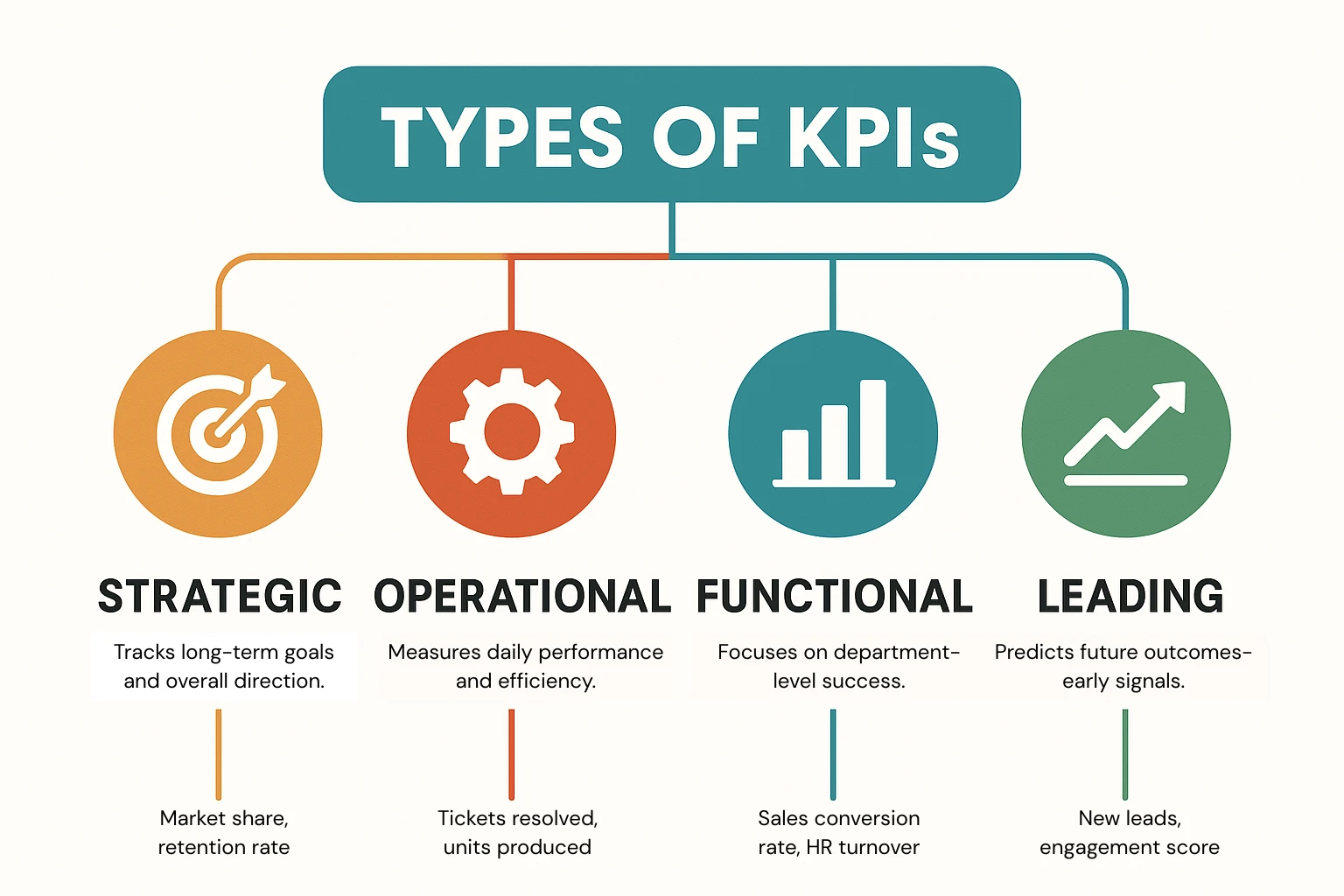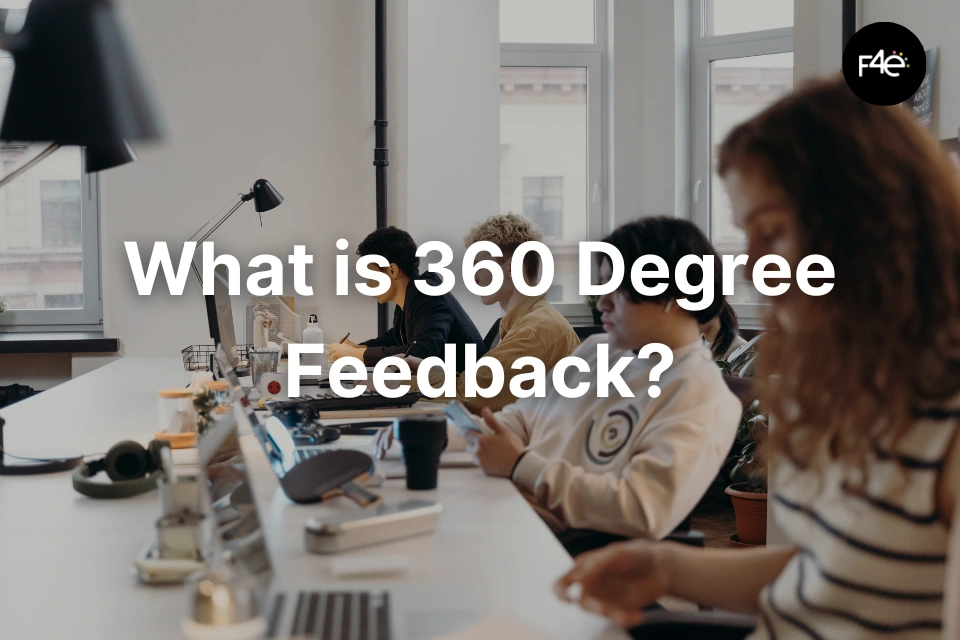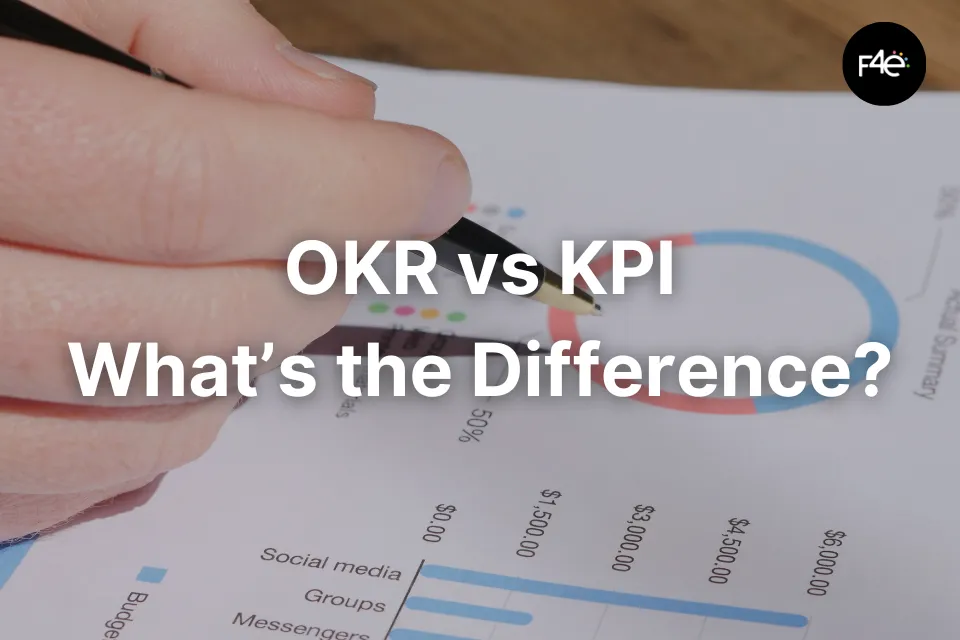KPIs are everywhere—on dashboards, in meetings, and across performance reviews—but they’re often misunderstood. Some treat them as simple metrics. Others inflate them into strategy. The reality is somewhere in between.
It’s not just about collecting data. KPIs focus attention, set priorities, and drive decisions that matter. With the right tools—like F4e—they become the backbone of transparent, aligned execution across teams.
What is a KPI?
A KPI (Key Performance Indicator) is a measurable value that reflects how well an individual, team, or organization is performing against a specific goal. It’s a tool for focus. Instead of tracking everything, you track what matters most.
At its core, a KPI answers a simple question: Are we on track?
Let’s say your sales team is aiming to close $100,000 in new deals this quarter. A relevant KPI might be “monthly closed-won revenue.” For a customer support team, it could be “average first response time.” These numbers don’t just show activity—they reveal progress toward outcomes.
KPIs are used in nearly every department:
- In marketing, you might track website conversion rate
- In operations, it could be order fulfillment time
- In HR, employee turnover rate is a common KPI
If you’re also exploring broader goal-setting frameworks, read our guide on What is an OKR?
KPIs are often the building blocks of those frameworks, but they can stand on their own. The key is choosing ones that actually reflect performance—not just movement. That’s why F4e supports both KPIs and OKRs—giving you the flexibility to adapt your approach as goals shift and teams evolve.
How to explain a KPI in an interview:
“A KPI is a metric that helps measure how well a team or company is progressing toward a specific goal. For example, in a past role, I used ‘customer response time’ as a KPI to improve our support quality.”
Why KPIs Matter
Teams are surrounded by numbers, but most of them don’t help anyone make better decisions. KPIs exist to fix that. They highlight the few metrics that actually reflect progress, risk, or impact—so people can act on them.
Without clear KPIs, priorities get fuzzy. You end up with teams working hard but pulling in different directions. With them, it becomes easier to focus, spot what’s working, and see when something needs to change.
And the connection to strategy isn’t optional. In one study, 95% of leading marketers said that “to truly matter, marketing analytics KPIs must be tied to broader business goals” (Think with Google).
That’s the point: KPIs aren’t about tracking for the sake of it. They’re useful when they guide decisions, help teams stay aligned, and make the bigger picture visible in day-to-day work.
What are Examples of KPIs?
KPIs only make sense when they’re grounded in the day-to-day work of a team. Here are some real-world examples, broken down by department:
HR
- Time to hire
- Employee turnover rate
- Offer acceptance rate
Marketing
- Website conversion rate
- Customer acquisition cost (CAC)
- Email open rate
Sales
- Monthly closed-won revenue
- Sales pipeline coverage
- Win rate (deals won ÷ deals created)
Customer Support
- First response time
- Ticket resolution time
- Customer satisfaction score (CSAT)
Finance
- Operating margin
- Revenue growth rate
- Budget variance
These KPIs are not one-size-fits-all. A fast-growing startup might prioritize “user acquisition cost,” while an established company might care more about “customer retention rate.” The right KPI depends on what you’re trying to achieve—and what you’re willing to act on.
What Makes a Good KPI?
Not every metric deserves to be a KPI. Just because something is measurable doesn’t mean it’s meaningful.
A good KPI is:
- Directly tied to a goal
- Clearly defined and easy to interpret
- Actionable — it tells you what to do next, not just what happened
- Tracked regularly — ideally in real-time or at predictable intervals
Here’s the difference:
Tracking number of website visits might sound useful, but if your goal is customer acquisition, it’s not enough. A better KPI could be conversion rate from website visit to sign-up. One gives you activity, the other gives you performance.
Also, beware of vanity metrics—numbers that look impressive but don’t drive real outcomes. Social media likes, app downloads, and total page views often fall into this trap unless they’re linked to an actual objective.
Good KPIs don’t live in isolation, either. They’re part of the broader performance system. F4e is built with this in mind—connecting KPIs to broader business strategy while letting you control transparency, ownership, and visibility as needed. Read our analysis on performance management best practices to see how KPIs fit into larger feedback, evaluation, and decision-making processes.
Types of KPIs

Not all KPIs measure the same thing—or serve the same purpose. Understanding the different types helps you choose the right indicator for the job.
1. Leading vs Lagging KPIs
- Leading KPIs predict future performance. They’re early signals.
Example: Number of qualified leads might indicate next quarter’s sales. - Lagging KPIs reflect past performance. They’re results-based.
Example: Total revenue from last month is a lagging indicator.
Both are useful. Leading KPIs help you course-correct early. Lagging KPIs help you evaluate outcomes.
2. Quantitative vs Qualitative KPIs
- Quantitative KPIs are numbers.
Example: Churn rate, net profit margin, employee absenteeism. - Qualitative KPIs are based on judgment, ratings, or observations.
Example: Employee engagement scores or customer feedback themes.
Some organizations avoid qualitative indicators, but when measured consistently, they can highlight patterns numbers miss.
3. Strategic vs Operational KPIs
- Strategic KPIs track long-term goals.
Example: Market share, brand awareness, retention rate. - Operational KPIs focus on day-to-day performance.
Example: Tickets resolved per day or units produced per hour.
Both should exist in balance. Too many strategic KPIs and you lose sight of daily performance. Too many operational KPIs and you miss the big picture. F4e helps maintain this balance with customizable dashboards that filter KPIs by type, department, or strategy alignment—so everyone from leadership to frontline teams stays aligned.
KPIs vs OKRs
KPIs and OKRs are often mentioned in the same breath, but they serve different purposes.
- KPIs measure performance. They tell you how you’re doing.
- OKRs (Objectives and Key Results) define what you want to achieve and how you’ll measure progress.
Think of it this way:
If your Objective is “Improve customer retention”, one of your Key Results might be “Increase monthly retention rate from 85% to 90%.” That retention rate? It’s a KPI.
In other words, KPIs are often embedded inside OKRs. But you can use KPIs without using OKRs, especially in organizations that don’t work with formal goal-setting frameworks.
For a deeper dive into how these two compare, check out our detailed breakdown of the differences between OKRs and KPIs. F4e is unique in that it’s designed to support both frameworks seamlessly, letting you implement what works best for your organization’s culture and maturity level.
Common Mistakes When Using KPIs
KPIs can sharpen focus—or create confusion. It all depends on how you use them. Here are some of the most common pitfalls:
1. Tracking too many KPIs
If everything is a priority, nothing is. Tracking 20 metrics dilutes focus. Stick to a handful that actually reflect performance and drive decisions.
2. Choosing irrelevant indicators
Sometimes teams measure what’s easy instead of what’s meaningful. If you’re tracking “emails sent” instead of “responses received,” you’re missing the point.
3. Ignoring KPI results
Collecting data but not acting on it turns KPIs into decoration. A good KPI should prompt a question or a decision: Why did this drop? What needs to change?
4. Misunderstanding the context
KPIs don’t live in a vacuum. A 5% churn rate might be great in one industry and alarming in another. Make sure your benchmarks are grounded in your business model and environment.
5. Using outdated indicators
Goals evolve. Outdated indicators can mislead teams or waste resources. Revisit them regularly, especially when priorities shift.
How to Choose the Right KPIs
Choosing KPIs shouldn’t start with the data you have—it should start with the goals you care about.
1. Work backward from the goal
What are you trying to improve, change, or maintain? Identify that first. Then ask: what metric would show progress toward that goal?
Example:
Goal: Improve onboarding experience
KPI: Time-to-productivity for new hires
2. Involve the people doing the work
KPIs shouldn’t be dictated top-down. Talk to the teams who will be measured. They’ll often know what really reflects performance—and what’s just noise. F4e makes this process easier with collaborative goal-setting tools that allow stakeholder input while preserving ownership and clarity.
3. Keep it simple and specific
Avoid vague indicators like “employee engagement” unless you have a clear way to define and measure them. The best KPIs are plain, sharp, and grounded in real outcomes.
4. Tie them to decision-making
If your KPI changes, what action would you take? If you can’t answer this question, you might be tracking the wrong thing.
5. Don’t fall in love with the number
KPIs are tools, not trophies. Hitting the number isn’t the end—it’s the start of a conversation about what’s working and what’s not.
KPI Tracking and Evaluation
Defining KPIs is only half the job—tracking and evaluating them is what gives them meaning.
Track consistently
Whether it’s daily, weekly, or monthly, set a rhythm. Irregular tracking leads to gaps, and gaps lead to guesses.
Use the right tools
Spreadsheets work for small teams, but they quickly become unwieldy. As organizations scale, purpose-built solutions like F4e provide real-time dashboards, automated notifications, and integrated reporting that make tracking both easier and more meaningful. F4e’s integrations with tools like Jira and Teams eliminate manual updates, ensuring your KPIs always reflect current reality without creating additional work.
Look beyond the number
Numbers don’t explain themselves. If a KPI drops, figure out why. If it improves, dig into what changed. The evaluation process should trigger discussion, not just reporting.
Update when priorities change
All KPIs have a shelf life. Review them quarterly to ensure alignment with current business goals. What worked last year might not work now—and that’s okay. F4e’s AI Assistant can help identify when KPIs need refreshing and even suggest alternatives based on your business strategy and historical performance patterns.
Conclusion
Performance metrics are valuable, but KPIs are more than just numbers—they’re tools for clarity, focus, and decision-making. Their effectiveness depends entirely on how they’re selected, tracked, and applied.
The challenge isn’t having data—it’s knowing what to pay attention to. Good KPIs cut through the noise and highlight what truly matters for your objectives.
Ready to transform how your organization handles KPIs? F4e makes setting, tracking, and acting on KPIs seamless—helping your teams stay aligned without the overhead. From AI-assisted KPI creation to real-time dashboards, transparency settings, and native integrations with the tools you already use, F4e turns performance management into a system that works quietly in the background, not one that slows you down. Learn more about how F4e can strengthen your performance management.








